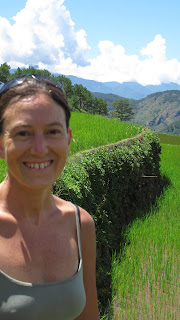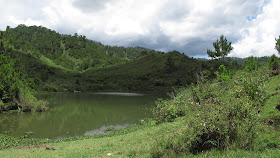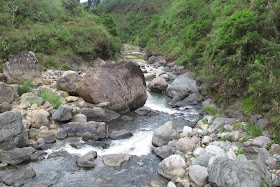

Sagada - Beautiful town in the mountains - now this was our style. We decided to stay for while and booked a room at Davey's Guesthouse for four nights.
The Lonely Planet guide describes Sagada as "backpackers paradise", and it's easy to see why. Sagada is a compact little community, mostly stretching along a single road edging the rim of a limestone canyon. Restaurants, cafes, shops, guide services and guesthouses- all owned and run by local residents (that's a law in Sagada) - line the street and offer endless options for entertainment, adventure or just relaxation. The prices are cheap by international standards - you can easily get by on $20 USD/day - and the vibe is mellow. The town has an official 9 pm curfew, which doesn't mean you have to be in your room at 9pm, but it does mean that they pretty much roll up the sidewalks then and if you're out and about, people will wonder what you're doing.


And the weather is blissfully temperate. After the sweltering heat and humidity of Manila and Baguio, the foggy drizzle in Sagada was a godsend. It reminded us a lot of Seattle - typically it rained in the evening and then would get up to a very pleasant 70 degrees or so during the day. We actually wore our fleeces several times and congratulated ourselves for not shipping them back to Seattle along with our camping gear.


The area around Sagada is spectacular, both geographically and culturally. The mountains - where they are not terraced in rice paddies - are covered with tropical pine trees and rimmed with mist and fog. And the rice terraces are truly a World Wonder (at least according to the Philippinos). Thousands of years old, these handmade structures that are hewn out of rock and earth supply the basic food for the communities around them. Though they mostly grow rice in the terraces, other vegetables are cultivated as well and can be found every morning before the traffic gets too bad for sale in the streets.


The terraces are still being worked by the people of Sagada and we were pleased to learn that they can only be owned by community members, ensuring that the land will not be bought and developed by outside interests. As one local said, "We don't want Sagada to end up like Baguio."


We used our time in Sagada to relax, plan the next phase of our trip down south to Dumaguete, and to do some sightseeing. One day, we took a guided tour around the outskirts of the town to see the hanging coffins suspended from the limestone cliffs less than a kilometer from the main square. These coffins belong to the locals tribes. If you were important in the tribe you were preserved and hung from the cliffs, if you were a commoner your coffin was put in one of the caves around Sagada. Often there would be a chair attached to the coffin. The chair had formerly supported the corpse during the wake, and underneath the seat a fire would burn to help preserve the body.
Side note:unlike most of the Philippines, Sagada is predominantly Anglican now, not Catholic.





The next day Giovannina spent caving in Sagada with another guide Jolly and two french friends we had met hiking.
We hired Giovannina's caving guide, to take us on an overnight trip to the Mainit Hot Springs. The hike was about 20 km long and traced it's way through the rice terraces between Sagada and Bontoc. The hiking was not a leisurely stroll, but consisted mostly of ascending and descending small stone stairways that made up the walls and dikes of the terraces.




The scenery was spectacular and we were blessed with good weather, but goodness was it hard work. We consider ourselves to be avid hikers, but this was more strenuous than anything in the Cascades. Yet, we were regularly passed by people of all ages - kids, adults, elderly women carrying sacks - who seemed to bound across the landscape, wearing nothing more than flip-flops and often just bare feet.

According to Jolly, there are few roads in the area and so this is how people get from one town to another. These pathways through the terraces ARE the roads.



We stopped for lunch next to a large waterfall and swimming hole. While we took a dip to cool off, Jolly and his partner, Randy, cooked us lunch: stewed chicken with rice and salted pork. They don't mess around when it comes to meals, and after the hiking we did, we understood why.



We finally reached the Mainit Hot Springs around 4 pm, put our things in the little cottage next to the pools and went for a soak. Once again, we found ourselves in concrete pools with hot water pumped into them. It was quite relaxing until about 7 pm when folks started showing up. Holy Week was starting soon and folks were beginning their vacations, which meant late night party at the hot springs. After an hour of politely listening to a young man attempt to persuade us (in broken English) to visit his restaurant, we decided to retire to our bed. The long day of hiking did the trick and we were soon asleep.
We spent another day in Sagada, mostly relaxing and preparing for our 13 hour bus trip back to Manila. Woody did treat himself to one local delicacy the last day: Civet Coffee. It costs over $100/cup to buy this in the States, so at $5 a cup Woody felt like he was getting a deal. The coffee is so special because - I'm not kidding here - the beans have been eaten by a wild cat (actually a weasel) and then pooped out. Someone collects the beans (presumably washing their hands afterwards) and then roasts them. The finished product is a very good - and strong - cup of coffee. But save yourself the money (and the cat poop jokes) and just buy a very good French roast from your local shop, it's just as good.
To see photos of our time in Sagada, check out the web album.
No comments:
Post a Comment